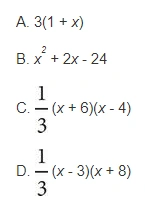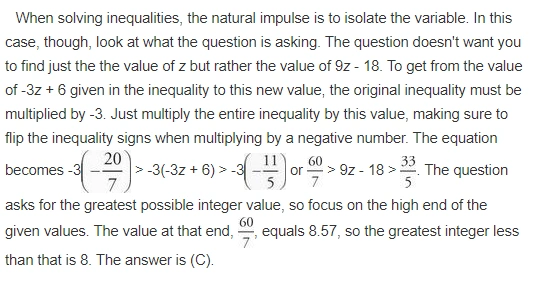The 2024 SAT standardized test is a critical assessment for college admissions. The math section covers a wide range of topics. To help students prepare, we’ve created a practice paper. This paper includes various math problems to help students become familiar with the test format and excel in their exam.
1. Bryan, who works in a high-end jewelry store, earns a base pay of $10.00 per hour plus a certain percent commission on the sales that he helps to broker in the store. Bryan worked an average of 35 hours per week over the past two weeks and helped to broker sales of $5,000.00 worth of jewelry during that same two-week period. If Bryan’s earnings for the two-week period were $850.00, what percent commission on sales does Bryan earn?
A. 1%
B. 2%
C. 3%
D. 4%
2. If \frac{(C+x)}{x-3}=\frac{x+8}{3} , which of the following could be an expression of C in terms of x ?

3. Lennon has 6 hours to spend in Ha Ha Tonka State Park. He plans to drive around the park at an average speed of 20 miles per hour, looking for a good trail to hike. Once he finds a trail he likes, he will spend the remainder of his time hiking it. He hopes to travel more than 60 miles total while in the park. If he hikes at an average speed of 1.5 miles per hour, which of the following systems of inequalities can be solved for the number of hours Lennon spends driving, d, and the number of hours he spends hiking, h, while he is at the park?
A. 1.5h + 20d > 60
h + d ≤ 6
B. 1.5h + 20d > 60
h + d ≥ 6
C. 1.5h + 20d < 60
h + d ≥ 360
D. 20h + 1.5d > 6
h + d ≤ 60
4. In a certain sporting goods manufacturing company, a quality control expert tests a randomly selected group of 1,000 tennis balls in order to determine how many contain defects. If this quality control expert discovered that 13 of the randomly selected tennis balls were defective, which of the following inferences would be most supported?
A. 98.7% of the company’s tennis balls are defective
B. 98.7% of the company’s tennis balls are not defective
C. 9.87% of the company’s tennis balls are defective
D. 9.87% of the company’s tennis balls are not defective
5. If -\frac{20}{7} < -3z + 6 < -\frac{11}{5} , what is the greatest possible integer value of 9z – 18 ?
A. 6
B. 7
C. 8
D. 9
Warning: Undefined variable $in_same_cat in /www/wwwroot/mtexam.com/public_html/wp-content/plugins/EXP.GKFEED.COM/function.php on line 27
Warning: Undefined variable $excluded_categories in /www/wwwroot/mtexam.com/public_html/wp-content/plugins/EXP.GKFEED.COM/function.php on line 27

